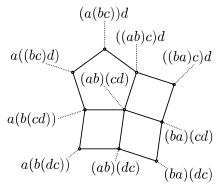

In mathematics, the permutoassociahedron is an -dimensional polytope whose vertices correspond to the bracketings of the permutations of terms and whose edges connect two bracketings that can be obtained from one another either by moving a pair of brackets using associativity or by transposing two consecutive terms that are not separated by a bracket.
The permutoassociahedron was first defined as a CW complex by Mikhail Kapranov who noted that this structure appears implicitly in Mac Lane's coherence theorem for symmetric and braided categories as well as in Vladimir Drinfeld's work on the Knizhnik–Zamolodchikov equations. It was constructed as a convex polytope by Victor Reiner and Günter M. Ziegler.
Examples
When , the vertices of the permutoassociahedron can be represented by bracketing all the permutations of three terms , , and . There are six such permutations, , , , , , and , and each of them admits two bracketings (obtained from one another by associativity). For instance, can be bracketed as or as . Hence, the -dimensional permutoassociahedron is the dodecagon with vertices , , , , , , , , , , , and .
When , the vertex is adjacent to exactly three other vertices of the permutoassociahedron: , , and . The first two vertices are reached from via associativity and the third via a transposition. The vertex is adjacent to four vertices. Two of them, and , are reached via associativity, and the other two, and , via a transposition. This illustrates that, in dimension and above, the permutoassociahedron is not a simple polytope.
Properties
The -dimensional permutoassociahedron has
vertices. This is the product between the number of permutations of terms and the number of all possible bracketings of any such permutation. The former number is equal to the factorial and the later is the th Catalan number.
By its description in terms of bracketed permutations, the 1-skeleton of the permutoassociahedron is a flip graph with two different kinds of flips (associativity and transpositions).
See also
References
- Kapranov, Mikhail M. (1993). "The permutoassociahedron, Mac Lane's coherence theorem and asymptotic zones for the KZ equation". Journal of Pure and Applied Algebra. 85 (2): 119–142. doi:10.1016/0022-4049(93)90049-Y.
- Reiner, Victor; Ziegler, Günter M. (1994). "Coxeter-associahedra". Mathematika. 41 (2): 364–393. doi:10.1112/S0025579300007452.
- Baralić, Djordje; Ivanović, Jelena; Petrić, Zoran (December 2019). "A simple permutoassociahedron". Discrete Mathematics. 342 (12): 111591. arXiv:1708.02482. doi:10.1016/j.disc.2019.07.007.
 and the correspondence between its vertices and the bracketed permutations of three terms
and the correspondence between its vertices and the bracketed permutations of three terms  ,
,  , and
, and  .
. that share vertex
that share vertex  . Three of these facets are quadrilaterals and the fourth is a pentagon.
. Three of these facets are quadrilaterals and the fourth is a pentagon. -dimensional
-dimensional  terms and whose edges connect two bracketings that can be obtained from one another either by moving a pair of brackets using
terms and whose edges connect two bracketings that can be obtained from one another either by moving a pair of brackets using  , the vertices of the permutoassociahedron can be represented by bracketing all the permutations of three terms
, the vertices of the permutoassociahedron can be represented by bracketing all the permutations of three terms  ,
,  ,
,  ,
,  ,
,  , and
, and  , and each of them admits two bracketings (obtained from one another by associativity). For instance,
, and each of them admits two bracketings (obtained from one another by associativity). For instance,  or as
or as  . Hence, the
. Hence, the  ,
,  ,
,  ,
,  ,
,  ,
,  ,
,  ,
,  ,
,  ,
,  , and
, and  , the vertex
, the vertex  is adjacent to exactly three other vertices of the permutoassociahedron:
is adjacent to exactly three other vertices of the permutoassociahedron:  , and
, and  . The first two vertices are reached from
. The first two vertices are reached from  , are reached via associativity, and the other two,
, are reached via associativity, and the other two,  and
and  , via a transposition. This illustrates that, in dimension
, via a transposition. This illustrates that, in dimension 
 and the later is the
and the later is the